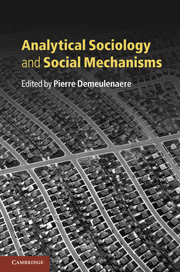Book contents
- Frontmatter
- Contents
- List of figures
- List of tables
- List of contributors
- Introduction
- Part I Action and mechanisms
- Part II Mechanisms and causality
- Part III Approaches to mechanisms
- 10 Youth unemployment: a self-reinforcing process?
- 11 Neighborhood effects, causal mechanisms and the social structure of the city
- 12 Social mechanisms and generative explanations: computational models with double agents
- 13 Relative deprivation in silico: agent-based models and causality in analytical sociology
- Index
- References
10 - Youth unemployment: a self-reinforcing process?
Published online by Cambridge University Press: 05 June 2012
- Frontmatter
- Contents
- List of figures
- List of tables
- List of contributors
- Introduction
- Part I Action and mechanisms
- Part II Mechanisms and causality
- Part III Approaches to mechanisms
- 10 Youth unemployment: a self-reinforcing process?
- 11 Neighborhood effects, causal mechanisms and the social structure of the city
- 12 Social mechanisms and generative explanations: computational models with double agents
- 13 Relative deprivation in silico: agent-based models and causality in analytical sociology
- Index
- References
Summary
Introduction
During the past two decades, social scientists and policy-makers, particularly in the United States, have paid increasing attention to neighborhood-based social interactions. Much of this upsurge in interest can be traced to the writings of William Julius Wilson on the importance of neighborhood characteristics in explaining inner-city social problems in the United States (e.g. Wilson 1987; see also Sampson et al. 2002).
This research is closely aligned with core themes in sociological theory and research, because social interactions are at the heart of sociology. A focus on social interactions is particularly salient among analytical sociologists because analytical sociology explains by detailing mechanisms through which social facts are brought about, and these mechanisms invariably refer to individuals' actions and the relations that link them to one another (see Hedström and Bearman 2009).
This chapter is concerned with the role of peer-based social interactions in explaining the length of unemployment spells and spatial variations in unemployment levels. We seek to specify in some detail why social interactions are important, and we use unique population-level panel data to assess their importance.
The questions addressed in the chapter are highly specific but the mechanisms we focus upon and the methods we use are much more general.
- Type
- Chapter
- Information
- Analytical Sociology and Social Mechanisms , pp. 201 - 226Publisher: Cambridge University PressPrint publication year: 2011
References
- 9
- Cited by



